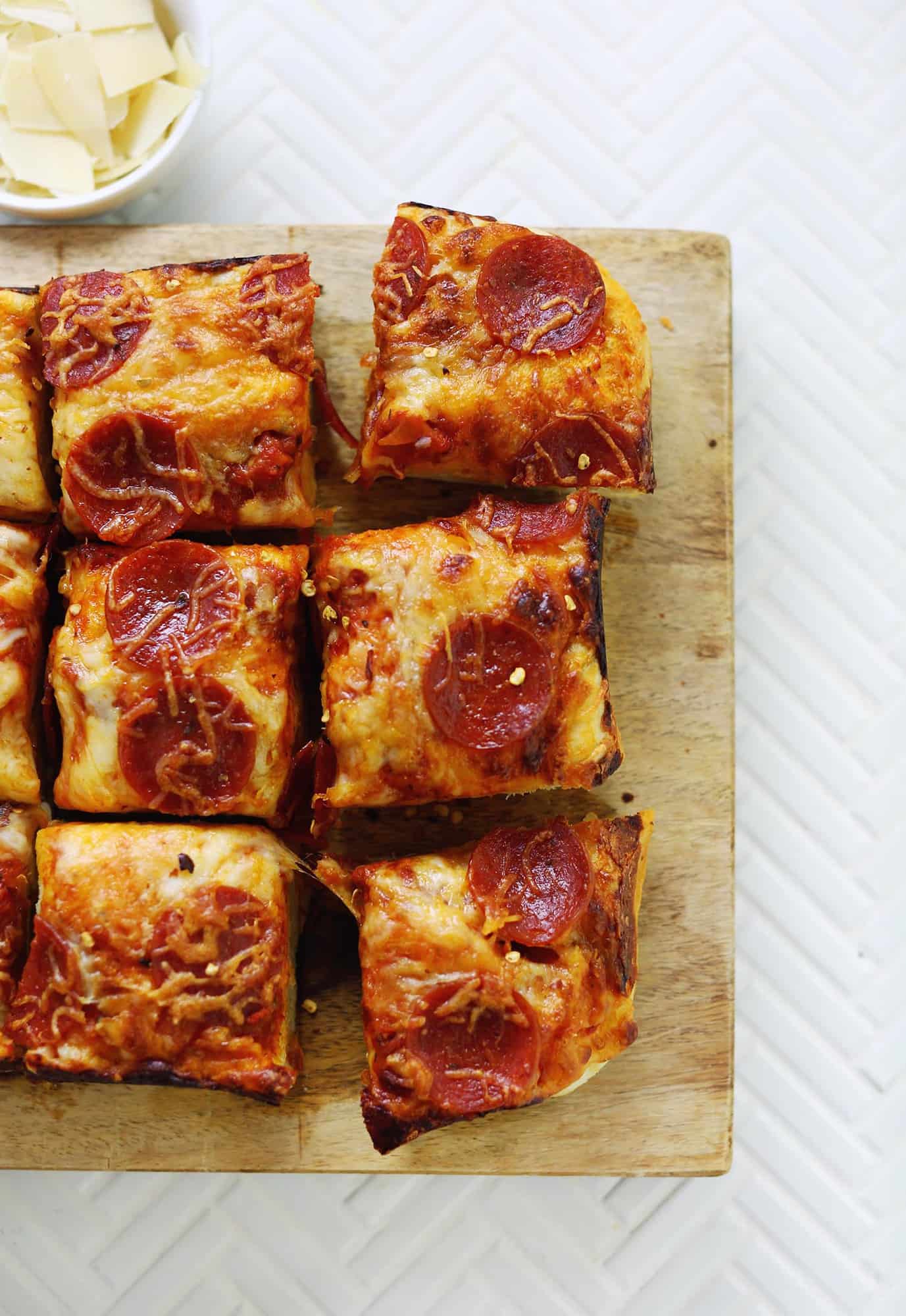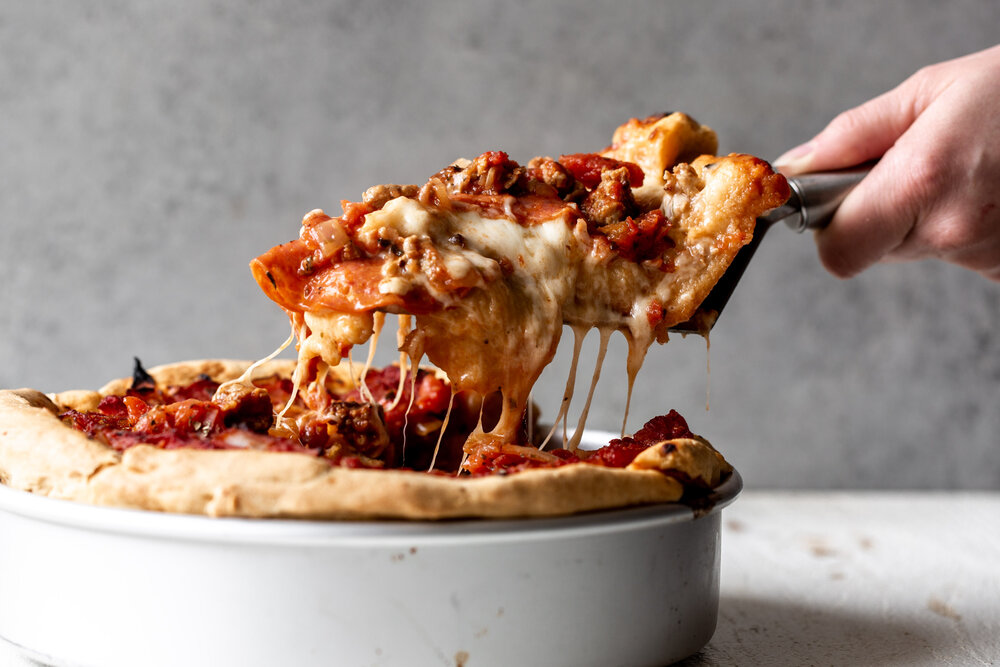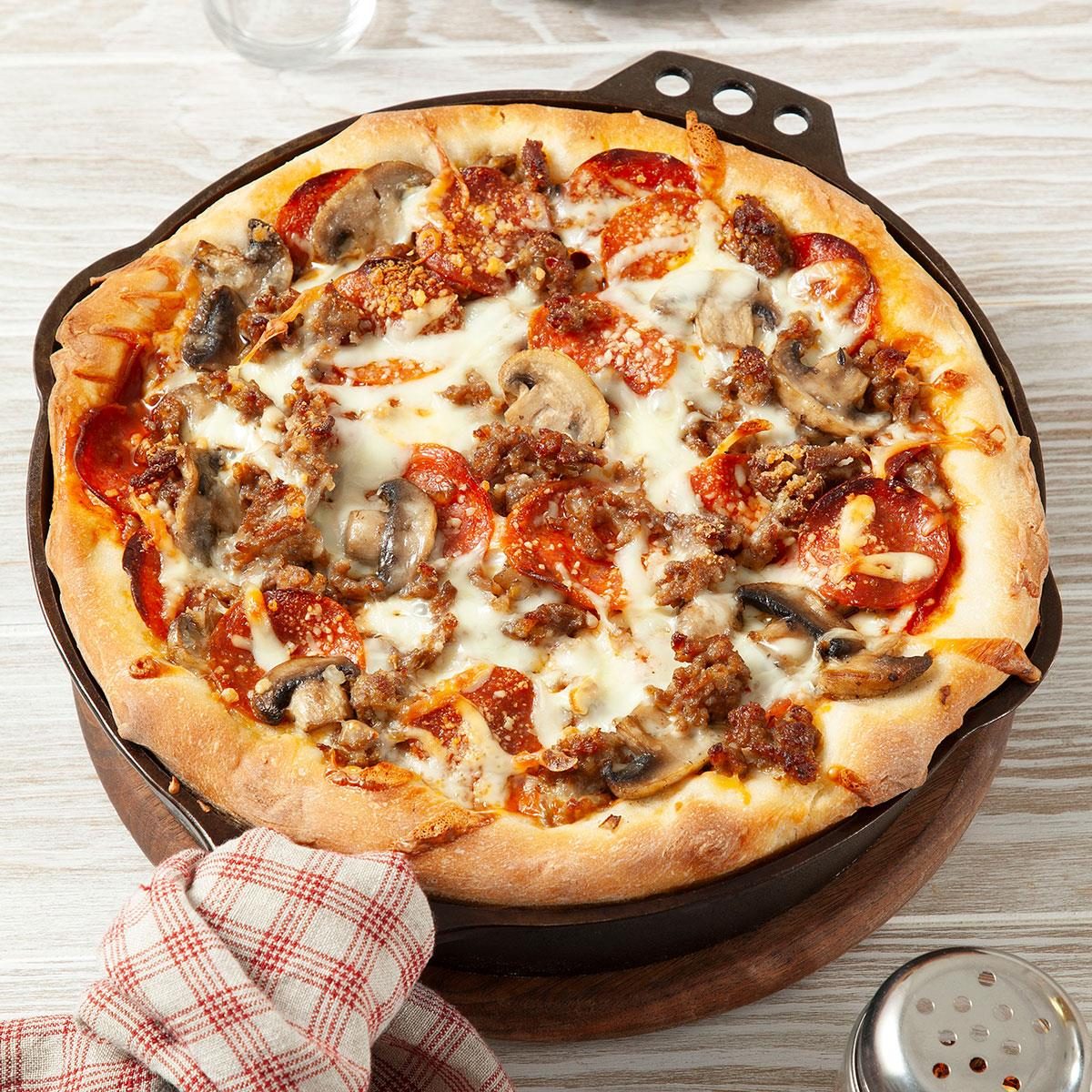Craving that hearty, cheesy, and satisfying deep-dish pizza but don’t want to leave your kitchen? You’re in the right place.
Making homemade deep-dish pizza is easier than you think, and once you try it, you’ll never want to order out again. Imagine biting into a golden, buttery crust filled with rich tomato sauce, gooey mozzarella, and your favorite toppings—all made just the way you like it.
In this guide, you’ll learn simple steps and insider tips to create an authentic deep-dish pizza that will impress your family and friends. Ready to roll up your sleeves and bake your own slice of comfort? Let’s get started!
Deep-dish Dough Basics
Deep-dish pizza dough forms the base of this iconic, hearty dish. It differs from regular pizza dough by being richer and more tender. This dough holds thick layers of cheese, sauce, and toppings without becoming soggy. Understanding the basics of deep-dish dough helps create the perfect crust for your homemade pizza.
The dough combines key ingredients and techniques to achieve its unique texture and flavor. Each step, from mixing ingredients to proofing, influences the final result. Let’s explore the essential elements of deep-dish dough.
Ingredients For Rich Dough
Deep-dish dough uses flour, water, yeast, and salt like other doughs. Butter or oil adds richness and tenderness. Sugar feeds the yeast and helps the dough brown. Some recipes call for milk instead of water for extra softness.
The quality of ingredients matters. Use bread flour for structure and fine granulated sugar. Fresh yeast gives better rise but dry yeast works well too. Measuring ingredients precisely keeps the dough consistent.
Fat’s Role In Texture
Fat makes deep-dish dough tender and flaky. Butter or corn oil coats flour particles, limiting gluten formation. This creates a softer, less chewy crust. Fat also improves flavor and helps the crust brown evenly.
Too little fat makes the dough tough and dry. Too much fat makes it greasy and heavy. Balancing fat ensures a crust that is crisp on the outside and soft inside.
Cornmeal And Other Additives
Cornmeal adds a slight crunch and a golden color to the crust. It also prevents the dough from sticking to the pan. Some recipes add a small amount of sugar or honey for sweetness.
Occasionally, eggs or milk powder enrich the dough further. These ingredients create a tender crumb and help with browning. Keep additives moderate to avoid altering dough structure.
Kneading And Proofing Tips
Knead the dough until smooth and elastic, about 8 to 10 minutes by hand. Proper kneading develops gluten for strength and stretch. Avoid over-kneading, which can make the crust tough.
Proof the dough in a warm place until doubled in size, usually 1 to 2 hours. This rest lets yeast ferment and dough rise. Punch it down gently after the first rise to release air bubbles.
Final shaping before baking is important. Press dough evenly into a deep pan. Let it rest briefly again to relax the gluten before adding toppings.
Choosing The Right Pan
Choosing the right pan is key for making perfect homemade deep-dish pizza. The pan affects the crust’s texture, cooking time, and ease of handling. Picking a suitable pan helps you achieve that classic thick, crispy crust with a soft inside.
Different pans offer unique benefits and change how your pizza bakes. Understanding these options ensures your pizza turns out delicious every time. Consider material, size, and how to prepare the pan before baking.
Cast Iron Vs. Steel Pans
Cast iron pans heat evenly and retain heat well. This creates a crispy, golden crust on your deep-dish pizza. They also add a slight smoky flavor during baking.
Steel pans heat up quickly and provide excellent heat conduction. They can create a thinner, crisper crust compared to cast iron. Steel pans are lighter and easier to handle.
Both pans work well, but cast iron is best for a thick, buttery crust. Steel pans suit those who prefer a crunchier bite.
Pan Size And Depth
Deep-dish pizza pans usually measure between 9 and 12 inches in diameter. The size affects cooking time and how much dough you need. A larger pan needs more dough and toppings.
Depth matters for the classic deep-dish style. Pans with 2 to 3 inches depth hold plenty of sauce, cheese, and toppings. Shallow pans won’t capture the full experience of deep-dish pizza.
Choose a size and depth that fits your appetite and oven space.
Preparing The Pan For Baking
Grease the pan well with oil or butter before adding the dough. This prevents sticking and helps the crust brown evenly. Use a high smoke point oil like vegetable or canola oil.
Preheat the pan in the oven for a few minutes before placing the dough. This jump-starts the crust cooking and helps create a crispy base.
Line the pan with parchment paper if you want easier cleanup. Press the dough gently into the corners and sides for an even layer.
Making The Sauce
Making the sauce is a key step in crafting a delicious deep-dish pizza. The sauce should be rich and thick to hold up to the deep crust and layers of cheese and toppings. It brings a fresh, vibrant flavor that balances the richness of the dough and cheese.
Choosing the right tomatoes and seasoning the sauce well will give your pizza an authentic taste. Cooking the sauce just right helps develop deep flavors without losing freshness.
Using Fresh Vs. Canned Tomatoes
Fresh tomatoes offer a bright, natural flavor perfect for summer pizzas. Peel and seed them for a smooth sauce. Canned tomatoes are convenient and consistent in taste all year. They often have a richer, cooked flavor. San Marzano canned tomatoes are a popular choice for authentic Italian sauces. Both options work well. Fresh tomatoes need more cooking time to break down. Canned tomatoes require less prep and cook quickly.
Seasoning For Authentic Flavor
Use simple herbs like basil and oregano to keep the sauce classic. Garlic adds depth and a bit of spice. Salt enhances all the flavors, while a pinch of sugar balances acidity. Red pepper flakes can add mild heat if desired. Fresh herbs give a bright taste, while dried herbs bring a deeper, mellow flavor. Season gradually and taste often to get the right balance.
Cooking The Sauce To Perfection
Start by sautéing garlic in olive oil for a fragrant base. Add tomatoes and bring to a gentle simmer. Cook slowly to reduce excess water and thicken the sauce. Stir occasionally to prevent burning. Simmering for 20 to 30 minutes allows flavors to meld. Avoid boiling hard; it can dull the fresh taste. The sauce should be thick but still spoonable. Cool before spreading on your deep-dish crust for best results.
Selecting Cheese And Toppings
Selecting the right cheese and toppings is key for making delicious homemade deep-dish pizza. The cheese must melt well and blend with the rich dough. Toppings add flavor and texture, making each bite exciting.
Choosing fresh and high-quality ingredients will improve your pizza. Balance the toppings to avoid sogginess and ensure even cooking. Here are some tips on picking cheeses and toppings that work best.
Best Cheeses For Deep-dish
Mozzarella is the classic choice for deep-dish pizza. It melts smoothly and creates a creamy texture. Use whole milk mozzarella for richer flavor and better stretch.
Cheddar adds sharpness and a bit of color. Parmesan gives a salty kick and works well sprinkled on top. Consider provolone or fontina for extra meltiness and mild taste.
Popular Meats And Vegetables
Sliced pepperoni and Italian sausage are popular meat options. They release flavorful oils that soak into the crust. Cook meats before adding to remove extra grease.
Vegetables like bell peppers, mushrooms, and onions add freshness and crunch. Spinach and black olives bring a nice contrast. Avoid watery veggies to keep the crust crispy.
Layering For Even Cooking
Start with a layer of cheese directly on the dough. This prevents the sauce from making the crust soggy. Add meats and vegetables next, spreading them evenly.
Top with a thick layer of tomato sauce. This creates the signature deep-dish look and flavor. Layering this way ensures all ingredients cook properly and the crust stays firm.
Assembling Your Pizza
Assembling your deep-dish pizza is a key step to get that perfect balance of flavors and textures. This process shapes the final taste and the look of your pizza. Careful assembly helps avoid common problems like soggy crust or uneven cooking. Follow simple techniques to press the dough right and layer ingredients in the best order.
Dough Pressing Techniques
Start by pressing the dough evenly into your deep-dish pan. Use your fingers to stretch the dough up the sides. Avoid tearing the dough by pressing gently and moving slowly. Make sure the dough covers the bottom and walls without holes. A smooth, even base prevents leaks and holds toppings well.
Order Of Ingredients
Place a layer of cheese directly on the dough first. This protects the crust from moisture in the sauce. Next, add your toppings like vegetables or meats. Finally, pour the tomato sauce over the top. This classic order keeps the crust crispy and lets the sauce shine.
Avoiding Soggy Crust
Use thick sauce to reduce water content that soaks the crust. Drain any wet toppings like mushrooms or spinach well before adding. Bake the pizza on a preheated oven rack or stone for better heat circulation. These steps help keep the crust firm and avoid sogginess.

Credit: abeautifulmess.com
Baking Tips
Baking homemade deep-dish pizza requires attention to oven temperature and timing. These factors help create a golden crust and melt the cheese perfectly. Follow these simple baking tips to enjoy a delicious deep-dish pizza straight from your oven.
Ideal Oven Temperature
Set your oven to 425°F (220°C) for the best results. This temperature allows the crust to cook evenly and the toppings to heat through. Avoid lower temperatures, which can make the crust soggy. A hot oven crisps the edges and locks in flavors.
Baking Time Guidelines
Bake your deep-dish pizza for about 30 to 40 minutes. Check the pizza after 25 minutes to avoid overcooking. The thick dough and dense toppings need extra time compared to thin-crust pizzas. Adjust time slightly based on your oven’s strength.
Checking For Doneness
Look for a golden-brown crust along the edges. The cheese on top should be bubbly and lightly browned. Use a toothpick or fork to test the crust near the center. It should come out clean without raw dough. Let the pizza cool for a few minutes before slicing.
Serving And Storing
Serving and storing homemade deep-dish pizza properly helps keep its flavors fresh. Enjoy your pizza hot and fresh from the oven for the best taste. Saving leftovers the right way ensures you can enjoy your pizza later without losing quality.
Slicing Deep-dish Pizza
Use a sharp, large knife or pizza cutter to slice deep-dish pizza. Cut straight down with firm pressure to avoid dragging toppings. Let the pizza cool for a few minutes before slicing to keep the cheese from sticking. Slice into square or wedge shapes depending on your pan and preference.
Storing Leftovers Properly
Allow the pizza to cool completely before storing. Wrap slices tightly in plastic wrap or aluminum foil to prevent drying out. Store wrapped slices in an airtight container or ziplock bag. Keep the pizza in the refrigerator for up to 3-4 days. For longer storage, freeze slices for up to 2 months.
Reheating Without Losing Quality
Reheat pizza in the oven for the best texture. Preheat oven to 375°F (190°C). Place pizza slices on a baking sheet and heat for 10-15 minutes. Use foil to cover the pizza if it browns too fast. Avoid microwaving to keep the crust crispy and cheese melty.
Troubleshooting Common Issues
Making homemade deep-dish pizza can be rewarding but challenging. Some common issues may arise during preparation. Troubleshooting these problems helps improve your pizza’s taste and texture. Here are solutions to frequent problems home cooks face.
Fixing Dough That’s Too Dense
Dense dough often means too much flour or not enough rising time. Use a kitchen scale to measure flour precisely. Avoid adding extra flour while kneading. Let the dough rise in a warm place until it doubles in size. This step makes the dough lighter and fluffier. Also, check your yeast’s expiration date to ensure it is active.
Preventing Burnt Edges
Burnt edges happen when the oven temperature is too high or cooking time is too long. Lower the oven temperature by 25°F and bake longer for even cooking. Use a metal pan with a thicker base to distribute heat well. Cover the crust edges with foil halfway through baking to protect them from burning. Rotate the pizza once during baking for uniform heat exposure.
Dealing With Watery Sauce
Watery sauce can make the pizza soggy. Cook your sauce on low heat to reduce excess liquid before spreading it on the dough. Use thick, canned tomato sauce or blend fresh tomatoes and simmer to thicken. Avoid adding too much sauce on your pizza. Drain any watery vegetables or toppings well before adding them.
Variations And Creative Twists
Deep-dish pizza is a canvas for creativity. Variations and twists keep this classic dish exciting. Small changes can lead to big flavor differences. This section explores ways to add variety to your homemade deep-dish pizza. Try these ideas to make your pizza unique and delicious.
Stuffed Deep-dish Options
Stuffed deep-dish pizza adds an extra layer of flavor and texture. Fill the pizza crust with cheese, meats, or vegetables before adding the sauce. Popular fillings include sausage, pepperoni, and ricotta cheese. You can also mix spinach and mushrooms for a fresh taste. This style offers a rich, hearty meal that satisfies every bite.
Vegetarian And Vegan Ideas
Vegetarian and vegan pizzas can be just as tasty as traditional ones. Use plant-based cheese or skip cheese for a lighter option. Load the pizza with colorful vegetables like bell peppers, olives, and zucchini. Adding tofu or tempeh brings protein to the dish. These options make deep-dish pizza accessible and delicious for all diets.
Experimenting With Flavored Crusts
The crust sets the tone for your pizza. Mix herbs like rosemary or basil into the dough for an aromatic touch. Add garlic powder or parmesan to the crust for extra flavor. Try a cornmeal crust for crunch and color. Flavored crusts elevate the pizza and make every bite interesting and new.

Credit: cookingwithcocktailrings.com

Credit: www.tasteofhome.com
Frequently Asked Questions
Is Deep Dish Pizza Dough Different From Regular Pizza Dough?
Deep dish pizza dough contains more fat like butter or oil and sometimes cornmeal, making it richer and flakier. It creates a crisp, tender crust unlike regular pizza dough, which is chewier and less fatty. This difference supports the heavy toppings and deep pan structure.
How To Make Homemade Deep Pan Pizza?
To make homemade deep pan pizza, prepare rich dough with butter or oil. Press into a deep pan, add sauce, cheese, and toppings. Bake at 425°F for 25-30 minutes until golden and bubbly. Let cool slightly before serving for best taste and texture.
What Kind Of Dough Is Used For Deep Dish?
Deep dish pizza dough is richer, containing more fat like butter or corn oil and sometimes cornmeal. It creates a crispy, tender crust unlike regular chewy pizza dough.
Can I Make Deep Dish Pizza With Store-bought Dough?
Yes, you can use store-bought dough for deep dish pizza. It may lack the rich, flaky texture of traditional deep-dish dough but works well for convenience. Press the dough thickly in a deep pan to hold toppings and bake until golden and cooked through.
Conclusion
Making homemade deep-dish pizza is fun and rewarding. You get to enjoy thick, cheesy slices right at home. Using the right dough and fresh ingredients makes all the difference. Take your time layering sauce, cheese, and toppings for the best flavor.
Serve it hot and watch everyone smile. Try this recipe to bring a taste of Chicago to your kitchen today. Enjoy every bite of your delicious homemade deep-dish pizza!
